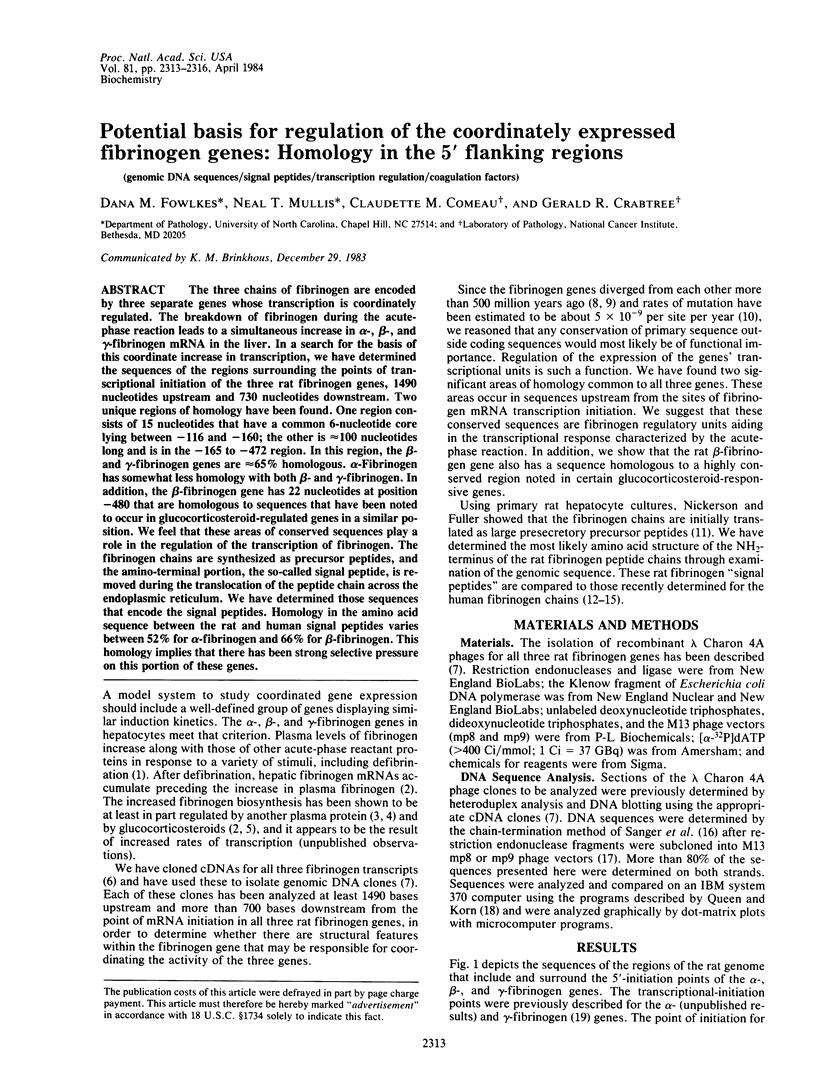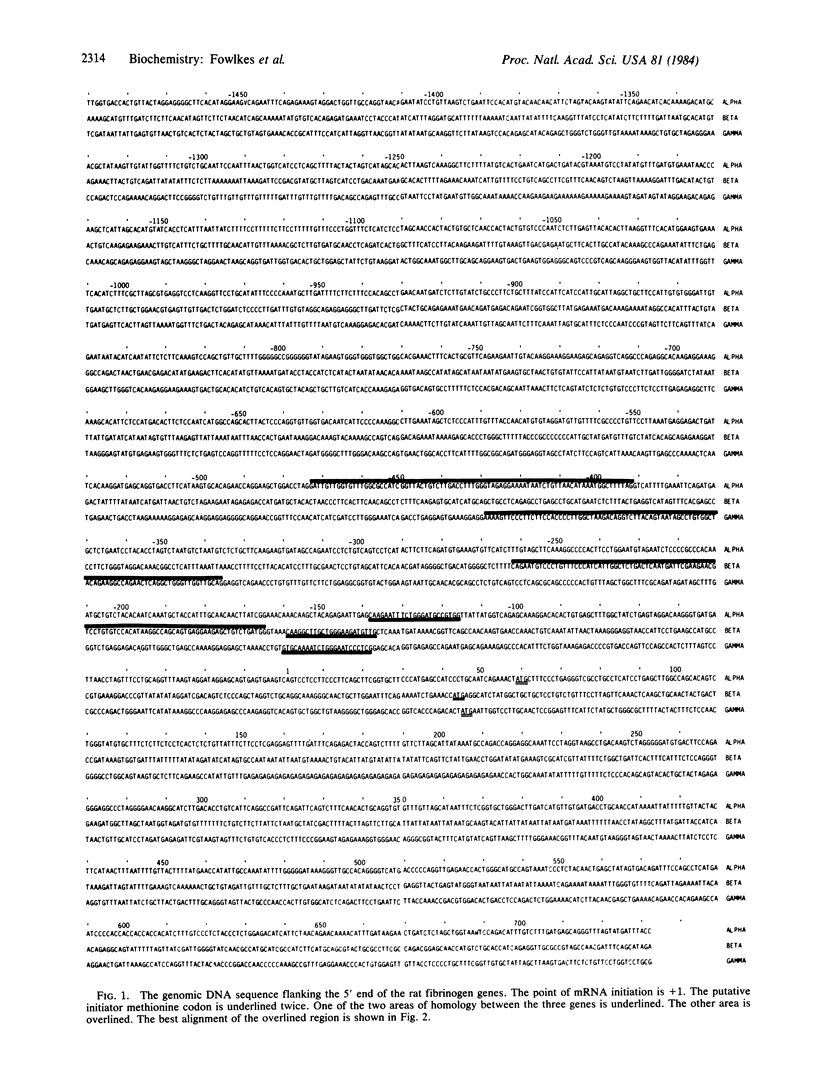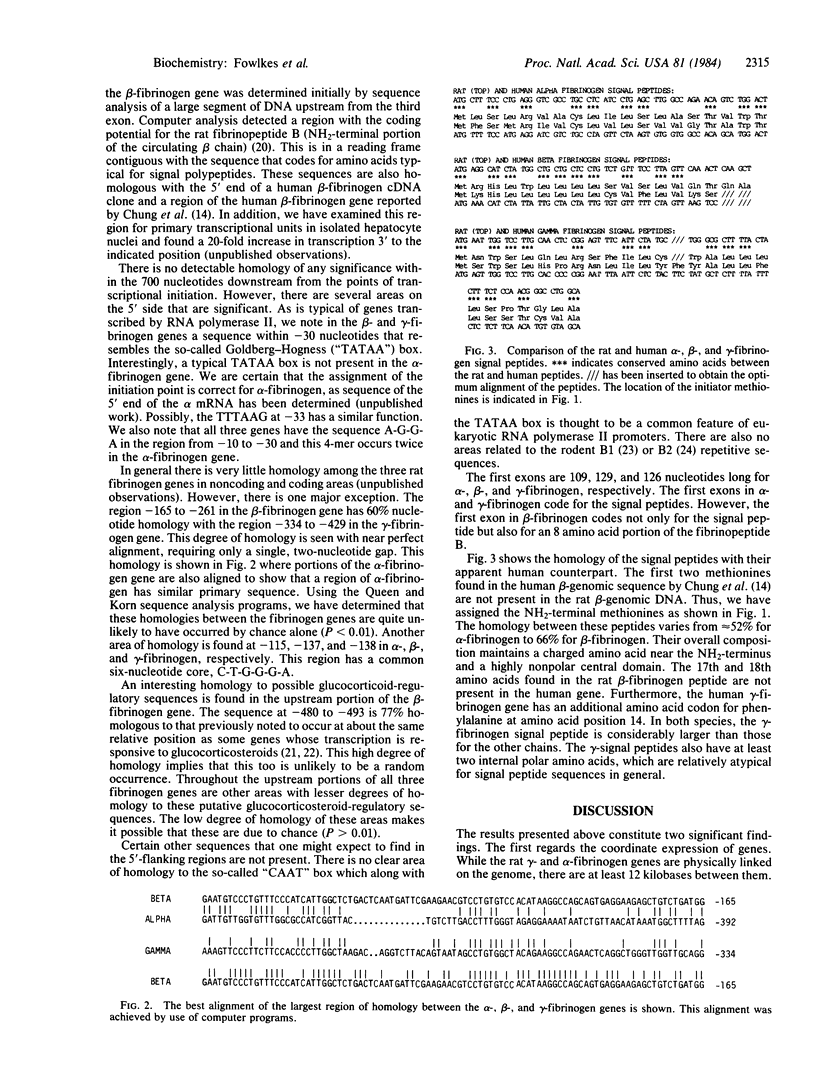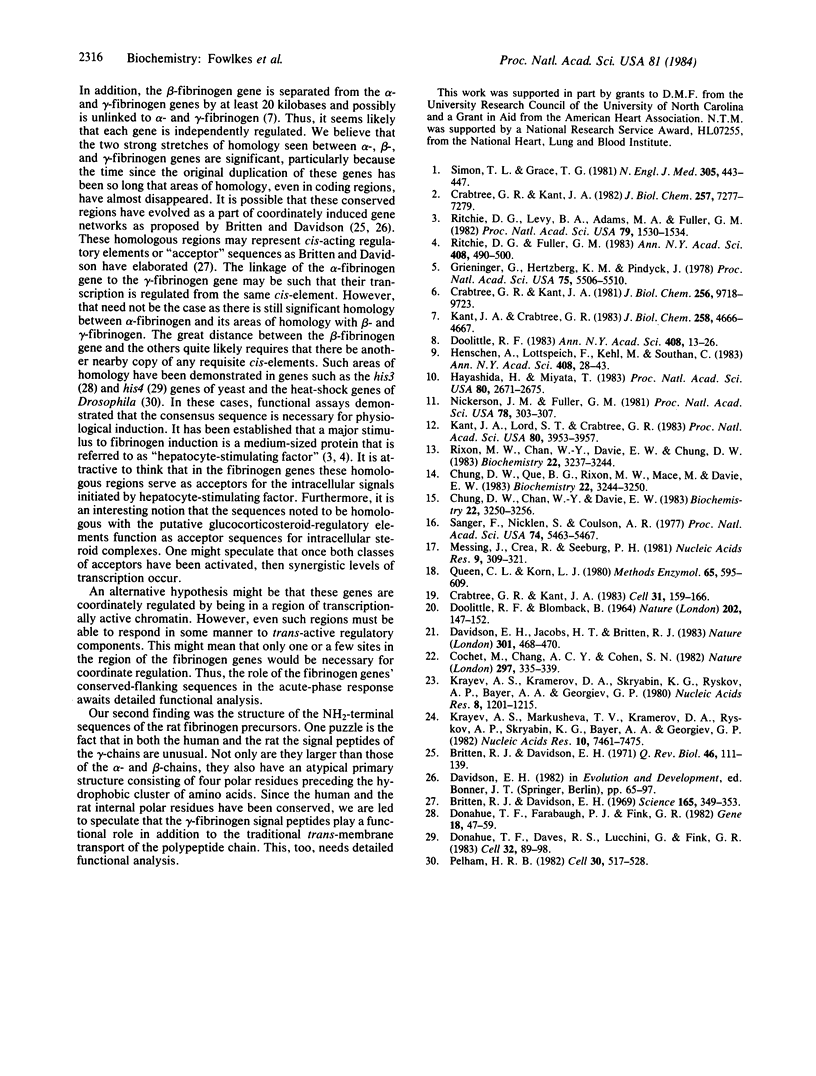Abstract
The three chains of fibrinogen are encoded by three separate genes whose transcription is coordinately regulated. The breakdown of fibrinogen during the acute-phase reaction leads to a simultaneous increase in alpha-, beta-, and gamma-fibrinogen mRNA in the liver. In a search for the basis of this coordinate increase in transcription, we have determined the sequences of the regions surrounding the points of transcriptional initiation of the three rat fibrinogen genes, 1490 nucleotides upstream and 730 nucleotides downstream. Two unique regions of homology have been found. One region consists of 15 nucleotides that have a common 6-nucleotide core lying between -116 and -160; the other is approximately equal to 100 nucleotides long and is in the -165 to -472 region. In this region, the beta- and gamma-fibrinogen genes are approximately equal to 65% homologous. alpha-Fibrinogen has somewhat less homology with both beta- and gamma-fibrinogen. In addition, the beta-fibrinogen gene has 22 nucleotides at position -480 that are homologous to sequences that have been noted to occur in glucocorticosteroid-regulated genes in a similar position. We feel that these areas of conserved sequences play a role in the regulation of the transcription of fibrinogen. The fibrinogen chains are synthesized as precursor peptides, and the amino-terminal portion, the so-called signal peptide, is removed during the translocation of the peptide chain across the endoplasmic reticulum. We have determined those sequences that encode the signal peptides. Homology in the amino acid sequence between the rat and human signal peptides varies between 52% for alpha-fibrinogen and 66% for beta-fibrinogen. This homology implies that there has been strong selective pressure on this portion of these genes.
Full text
PDF



Selected References
These references are in PubMed. This may not be the complete list of references from this article.
- Britten R. J., Davidson E. H. Gene regulation for higher cells: a theory. Science. 1969 Jul 25;165(3891):349–357. doi: 10.1126/science.165.3891.349. [DOI] [PubMed] [Google Scholar]
- Britten R. J., Davidson E. H. Repetitive and non-repetitive DNA sequences and a speculation on the origins of evolutionary novelty. Q Rev Biol. 1971 Jun;46(2):111–138. doi: 10.1086/406830. [DOI] [PubMed] [Google Scholar]
- Chung D. W., Chan W. Y., Davie E. W. Characterization of a complementary deoxyribonucleic acid coding for the gamma chain of human fibrinogen. Biochemistry. 1983 Jun 21;22(13):3250–3256. doi: 10.1021/bi00282a033. [DOI] [PubMed] [Google Scholar]
- Chung D. W., Que B. G., Rixon M. W., Mace M., Jr, Davie E. W. Characterization of complementary deoxyribonucleic acid and genomic deoxyribonucleic acid for the beta chain of human fibrinogen. Biochemistry. 1983 Jun 21;22(13):3244–3250. doi: 10.1021/bi00282a032. [DOI] [PubMed] [Google Scholar]
- Cochet M., Chang A. C., Cohen S. N. Characterization of the structural gene and putative 5'-regulatory sequences for human proopiomelanocortin. Nature. 1982 May 27;297(5864):335–339. doi: 10.1038/297335a0. [DOI] [PubMed] [Google Scholar]
- Crabtree G. R., Kant J. A. Coordinate accumulation of the mRNAs for the alpha, beta, and gamma chains of rat fibrinogen following defibrination. J Biol Chem. 1982 Jul 10;257(13):7277–7279. [PubMed] [Google Scholar]
- Crabtree G. R., Kant J. A. Molecular cloning of cDNA for the alpha, beta, and gamma chains of rat fibrinogen. A family of coordinately regulated genes. J Biol Chem. 1981 Sep 25;256(18):9718–9723. [PubMed] [Google Scholar]
- Crabtree G. R., Kant J. A. Organization of the rat gamma-fibrinogen gene: alternative mRNA splice patterns produce the gamma A and gamma B (gamma ') chains of fibrinogen. Cell. 1982 Nov;31(1):159–166. doi: 10.1016/0092-8674(82)90415-9. [DOI] [PubMed] [Google Scholar]
- DOOLITTLE R. F., BLOMBAECK B. AMINO-ACID SEQUENCE INVESTIGATIONS OF FIBRINOPEPTIDES FROM VARIOUS MAMMALS: EVOLUTIONARY IMPLICATIONS. Nature. 1964 Apr 11;202:147–152. doi: 10.1038/202147a0. [DOI] [PubMed] [Google Scholar]
- Davidson E. H., Jacobs H. T., Britten R. J. Very short repeats and coordinate induction of genes. Nature. 1983 Feb 10;301(5900):468–470. doi: 10.1038/301468a0. [DOI] [PubMed] [Google Scholar]
- Donahue T. F., Daves R. S., Lucchini G., Fink G. R. A short nucleotide sequence required for regulation of HIS4 by the general control system of yeast. Cell. 1983 Jan;32(1):89–98. doi: 10.1016/0092-8674(83)90499-3. [DOI] [PubMed] [Google Scholar]
- Donahue T. F., Farabaugh P. J., Fink G. R. The nucleotide sequence of the HIS4 region of yeast. Gene. 1982 Apr;18(1):47–59. doi: 10.1016/0378-1119(82)90055-5. [DOI] [PubMed] [Google Scholar]
- Doolittle R. F. The structure and evolution of vertebrate fibrinogen. Ann N Y Acad Sci. 1983 Jun 27;408:13–27. doi: 10.1111/j.1749-6632.1983.tb23231.x. [DOI] [PubMed] [Google Scholar]
- Grieninger G., Hertzberg K. M., Pindyck J. Fibrinogen synthesis in serum-free hepatocyte cultures: stimulation by glucocorticoids. Proc Natl Acad Sci U S A. 1978 Nov;75(11):5506–5510. doi: 10.1073/pnas.75.11.5506. [DOI] [PMC free article] [PubMed] [Google Scholar]
- Hayashida H., Miyata T. Unusual evolutionary conservation and frequent DNA segment exchange in class I genes of the major histocompatibility complex. Proc Natl Acad Sci U S A. 1983 May;80(9):2671–2675. doi: 10.1073/pnas.80.9.2671. [DOI] [PMC free article] [PubMed] [Google Scholar]
- Henschen A., Lottspeich F., Kehl M., Southan C. Covalent structure of fibrinogen. Ann N Y Acad Sci. 1983 Jun 27;408:28–43. doi: 10.1111/j.1749-6632.1983.tb23232.x. [DOI] [PubMed] [Google Scholar]
- Kant J. A., Crabtree G. R. The rat fibrinogen genes. Linkage of the A alpha and gamma chain genes. J Biol Chem. 1983 Apr 25;258(8):4666–4667. [PubMed] [Google Scholar]
- Kant J. A., Lord S. T., Crabtree G. R. Partial mRNA sequences for human A alpha, B beta, and gamma fibrinogen chains: evolutionary and functional implications. Proc Natl Acad Sci U S A. 1983 Jul;80(13):3953–3957. doi: 10.1073/pnas.80.13.3953. [DOI] [PMC free article] [PubMed] [Google Scholar]
- Krayev A. S., Kramerov D. A., Skryabin K. G., Ryskov A. P., Bayev A. A., Georgiev G. P. The nucleotide sequence of the ubiquitous repetitive DNA sequence B1 complementary to the most abundant class of mouse fold-back RNA. Nucleic Acids Res. 1980 Mar 25;8(6):1201–1215. doi: 10.1093/nar/8.6.1201. [DOI] [PMC free article] [PubMed] [Google Scholar]
- Krayev A. S., Markusheva T. V., Kramerov D. A., Ryskov A. P., Skryabin K. G., Bayev A. A., Georgiev G. P. Ubiquitous transposon-like repeats B1 and B2 of the mouse genome: B2 sequencing. Nucleic Acids Res. 1982 Dec 11;10(23):7461–7475. doi: 10.1093/nar/10.23.7461. [DOI] [PMC free article] [PubMed] [Google Scholar]
- Messing J., Crea R., Seeburg P. H. A system for shotgun DNA sequencing. Nucleic Acids Res. 1981 Jan 24;9(2):309–321. doi: 10.1093/nar/9.2.309. [DOI] [PMC free article] [PubMed] [Google Scholar]
- Nickerson J. M., Fuller G. M. In vitro synthesis of rat fibrinogen: identification of preA alpha, preB beta, and pre gamma polypeptides. Proc Natl Acad Sci U S A. 1981 Jan;78(1):303–307. doi: 10.1073/pnas.78.1.303. [DOI] [PMC free article] [PubMed] [Google Scholar]
- Pelham H. R. A regulatory upstream promoter element in the Drosophila hsp 70 heat-shock gene. Cell. 1982 Sep;30(2):517–528. doi: 10.1016/0092-8674(82)90249-5. [DOI] [PubMed] [Google Scholar]
- Queen C. L., Korn L. J. Computer analysis of nucleic acids and proteins. Methods Enzymol. 1980;65(1):595–609. doi: 10.1016/s0076-6879(80)65062-9. [DOI] [PubMed] [Google Scholar]
- Ritchie D. G., Fuller G. M. Hepatocyte-stimulating factor: a monocyte-derived acute-phase regulatory protein. Ann N Y Acad Sci. 1983 Jun 27;408:490–502. doi: 10.1111/j.1749-6632.1983.tb23268.x. [DOI] [PubMed] [Google Scholar]
- Ritchie D. G., Levy B. A., Adams M. A., Fuller G. M. Regulation of fibrinogen synthesis by plasmin-derived fragments of fibrinogen and fibrin: an indirect feedback pathway. Proc Natl Acad Sci U S A. 1982 Mar;79(5):1530–1534. doi: 10.1073/pnas.79.5.1530. [DOI] [PMC free article] [PubMed] [Google Scholar]
- Rixon M. W., Chan W. Y., Davie E. W., Chung D. W. Characterization of a complementary deoxyribonucleic acid coding for the alpha chain of human fibrinogen. Biochemistry. 1983 Jun 21;22(13):3237–3244. doi: 10.1021/bi00282a031. [DOI] [PubMed] [Google Scholar]
- Sanger F., Nicklen S., Coulson A. R. DNA sequencing with chain-terminating inhibitors. Proc Natl Acad Sci U S A. 1977 Dec;74(12):5463–5467. doi: 10.1073/pnas.74.12.5463. [DOI] [PMC free article] [PubMed] [Google Scholar]
- Simon T. L., Grace T. G. Envenomation coagulopathy in wounds from pit vipers. N Engl J Med. 1981 Aug 20;305(8):443–447. doi: 10.1056/NEJM198108203050808. [DOI] [PubMed] [Google Scholar]


